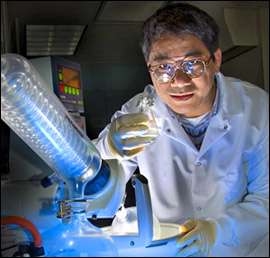Cerium oxide nanotubes get noticed

Chemists and materials scientists often study "nanotubes" -- capsule-shaped molecules only a few billionths of a meter in width. In nanotube form, many materials take on useful, unique properties, such as physical strength and excellent conductivity. Carbon nanotubes are the most widely investigated variety. Now, in pioneering research, scientists at the U.S. DoE's Brookhaven National Laboratory have created and investigated the properties of nanotubes made of a different, yet equally interesting material: cerium oxide.
"Cerium oxide nanotubes have potential applications as catalysts in vehicle emission-control systems and even fuel cells," says Brookhaven chemist Wei-Qiang Han, the lead scientist involved in the work. "But until very recently, they haven't been studied."
Han and his colleagues are in the midst of ongoing research into the structure and properties of cerium oxide nanotubes. As part of this, they have devised a method to synthesize cerium oxide nanotubes of high quality. First, they allow the compounds cerium nitrate and ammonia hydroxide to chemically react. Initially, this reaction forms "one-dimensional" nanostructures, such as rods and sheets, made of the intermediate product cerium hydroxide. The intermediate product is then quickly cooled to zero degrees Celsius, which freezes those structures into place. By letting the chemical reaction proceed over a long period of time, a process called "aging," the hydrogen is eventually removed from the intermediate product and a large quantity of the desired end product -- cerium oxide nanotubes -- is formed.
Han will explain this synthesis method at the American Chemical Society National Meeting in Atlanta, Georgia.
During his talk, Han will also discuss his group's recent study -- how cerium oxide nanotubes release oxygen ions when immersed in a low-oxygen environment, a process that is critical to the nanotubes' effectiveness as catalysts. To do this, the researchers have used several techniques. These include "transmission electron microscopy," a very powerful imaging technique, and two x-ray techniques, which they performed at Brookhaven's National Synchrotron Light Source.
"We're interested in studying oxygen-atom vacancies in cerium oxide nanotubes because, when combined with their other surface features, these vacancies may make them more functional and effective in the applications mentioned," Han said.
Source: Brookhaven National Laboratory















